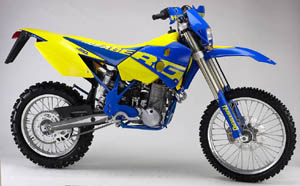
Little Husaberg illustrates perfectly the advantages modern manufacturing technology has brought to small manufacturers. Without the committee decision making, and general inertia, of a large corporation, Husaberg and other small manufacturers are free to follow the gut instinct of their leaders and transform ideas into products quickly and efficiently.
Husaberg made dramatic changes to its offroad line up last year — resulting in the lightest four-stroke motocrossers and enduro bikes ever made available to the public as production machinery. Owned by KTM, Husaberg was overshadowed somewhat by KTM’s publicity machine — KTM introduced its own revolutionary four-stroke designs last year.
So, what’s new with Husaberg in the 2001 model year? Quite a bit, actually.
Husabergs have had a reputation for high performance, and poor reliability, for several years. Husaberg has been addressing its machines’ reliability in recent years, but Husaberg took on the reliability issue head-on for 2001. Before discussing that aspect of the changes to the 2001 Husabergs, however (that subject is relatively boring, isn’t it?), let’s talk about the more interesting news.
First, and foremost, are the new displacement motocross machines — displacing 470cc and 550cc. These two machines feature a very large bore and short stroke (particularly the 470), for a broad powerband, and high rpm performance. The bore and stroke of the 470, for example, is 100mm x 60.1mm.
All of the Husaberg engines for 2001 feature a new balance shaft design (placed on the crankshaft itself), which purports to minimize vibration and also reduce the gyroscopic forces that inhibit quick handling. According to Husaberg, the new machines handle better than ever.
Last year’s engine sizes, including the 400, 501 and 650, will re-appear on the enduro models (featuring lightweight electric starters).
In the chassis department, new 48mm forks (again, manufactured by WP) are unique to Husaberg. These are very large diameter forks for an upside-down design, and should feature tremendous rigidity. Along with a redesigned PDS linkage-less shock absorber, an all-new swingarm (thirty percent lighter than last year, but just as strong) is featured. Husaberg also points out that it is now manufacturing a new exhaust system for all of its bikes in-house. Apparently, Husaberg had problems with its exhaust system suppliers last year, and claims that improved quality and performance will result from this change. Other, relatively minor changes have been made to the bikes, including a smaller, lighter battery on the electric start models, and reinforcements on the motocross frames.
One last comment about engine performance. Through a combination of new valves, new gear ratios, new ignition curves and new carburetor settings, Husaberg claims that engine performance is up in virtually all models.
Now, for the reliability news — a quote from Husaberg’s material provided to its importers and distributors (edited for slight grammar and spelling changes only – the Swedes have a way with English):
But despite all the new sizes and improved handling, the real target for model 2001 has been to improve the reliability of the engine, without losing power or adding a lot of weight. What we have done to this is the following: lubrication into the needle bearings in the crankshaft (with pressure), lubrication inside the rocker arms with pressure that also lubricates the rollers as well as the valves in the cylinder head, lubrication inside the secondary shaft to the gearbox (for the gearwheels running without needle bearings). We have also put a bigger needle bearing in the crankshaft, a bigger pin in the crankshaft, and also widened the size of the small end of the connecting rod, all in order to increase the lifetime of these parts.
We have also tried to get the engine running cooler to avoid any kind of over-heating problems. In order to do this, we are now working with a cylinder liner instead of the normal cylinder. This means that the water not only cools the cylinder, it also cools the crankcases along with the oil in the crankcases. We have also moved the water pump down the transmission cover, increasing the speed of the rotor to the double and then also the water flow through the system. If this was not enough, we have also changed the direction of the water through the system so now we push the water up through the cylinder liner, into the cylinder head and then to the radiator. Doing this minimize the risk of having boiling problems due to air in the cylinder head.
Other small but important things in the new engine are things like we now are having an oil inspection window on the transmission cover, two step ignition on all bikes, a new stator design from SEM with improved heat resistance, a re-designed hydraulic clutch (more lift than before), new clutch hose and many more small items (new gear box supplier, using forged gear wheels, a lot of gears ground in order to bring down the noise level from engine, changed casting for improved strength of crankcases, put the cylinder head directly on the crankcases in order to have the top end absolutely stabile, etc., etc.).





